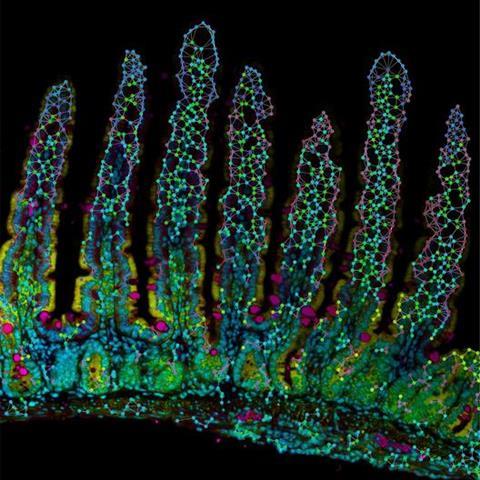The human immune system is like an army of specialized soldiers (immune cells) each with a unique role to play in fighting disease. In a new study published in Nature, led by scientists at the Allen Institute, La Jolla Institute for Immunology, and UC San Diego, researchers reveal how cells known as tissue-resident memory CD8 T cells, play unique and specialized roles based on where they are located within the small intestine.

Tissue-resident memory cells provide a local first line of defense against re-infection and call for “backup” from other immune cells and are also critical for maintaining peace in a tissue exposed to many outside pathogens.
This discovery sheds light on how tissue-resident memory CD8 T cells adapt to their location in the body, ensuring a coordinated and effective immune response and how microenvironments and cellular interactions shape this location-specific adaptation. Ultimately, location matters, and this understanding could also lead to improved immunotherapy and vaccines.
Specialized roles
The study shows that tissue-resident memory CD8 T cells in the small intestine are diverse with distinct responsibilities, and their position inside the gut’s architecture dictates what they do.
1. The frontline: At the villus tips, a subset of tissue-resident memory CD8 T cells with a higher killing capacity are positioned like guards in watchtowers. These cells are designed to attack invading pathogens immediately, preventing infections from spreading further.
2. Reinforcements: In a pocket of cells called the crypts, a different subset of tissue-resident memory CD8 T cells, which act as reserve forces, stand ready to respond should the body encounter the same pathogen in the future. These cells provide long-lasting immunity.
Strategically positioned
“What really struck me is that we have been able to see that immune cells in distinct locations have these special functions,” said Maximilian Heeg, M.D., one of the study’s lead co-authors and investigator at the Allen Institute. “They’re strategically positioned in the small intestine to fulfill their function, and this is the key finding from the paper.”
READ MORE: Study reveals how our gut cells detect harmful invaders
READ MORE: Chronic stress accelerates colorectal cancer progression by disrupting balance of gut microbiota
These differences ensure the immune system can react quickly to immediate threats while simultaneously maintaining a backup defense for long term protection.
“In response to infection, immune cells stream into tissues to fight infection and help repair damage. Importantly, these cells ‘talk to’ the tissue cells to coordinate the immune response. In this study, we can now visualize how the functional state of an immune cell relates to which cells and signals are found in different neighborhoods or regions of the tissues. This new knowledge of how the immune system works in tissues is game changing as we explore how to enhance immune protection while avoiding damaging inflammation,” said Ananda W. Goldrath, Ph.D., executive vice president of the Allen Institute for Immunology.
Understanding microenvironments and cellular i Interactions
Using advanced transcriptional profiling techniques, the researchers mapped the genetic instructions that instruct the behavior of tissue-resident memory CD8 T cells based on their location.
“I am most excited about the possibilities our new approaches bring: Studying immune cells in their unperturbed natural environments at high plex, throughput and resolution,” said Miguel Reina-Campos, Ph.D., study co-author and assistant professor at La Jolla Institute for Immunology.
The findings provide insight for designing better immunotherapies and vaccines. By targeting the mechanisms that direct tissue-resident memory CD8 T cells to specific sites inside a tissue and enhance their capabilities, researchers hope to develop treatments to boost the immune system’s effectiveness and keep us healthy.
“One part of this work was discovering causal relationships between well-characterized genes and CD8 T cell spatial and transcriptional phenotypes,” said study co-first author Alex Monell, a UC San Diego graduate student working with Goldrath. “We are expanding our CRISPR pooled spatial screening to profile the impacts of many types of genetic perturbations at once within CD8 T cells with an overarching goal of finding and manipulating modulatory mechanisms of tissue-specific immunity.”
Future research goals
This work highlights the importance of anatomical niches in shaping immune responses and establishes a framework for studying how immune cells interact with their environment. It presents new approaches in treating chronic diseases, infections, and inflammatory disorders by leveraging the unique dynamics of tissue-resident memory immune cells in barrier tissues.
Moving forward, the group is focused on understanding how this knowledge can be used to therapeutically target our immune responses.







No comments yet